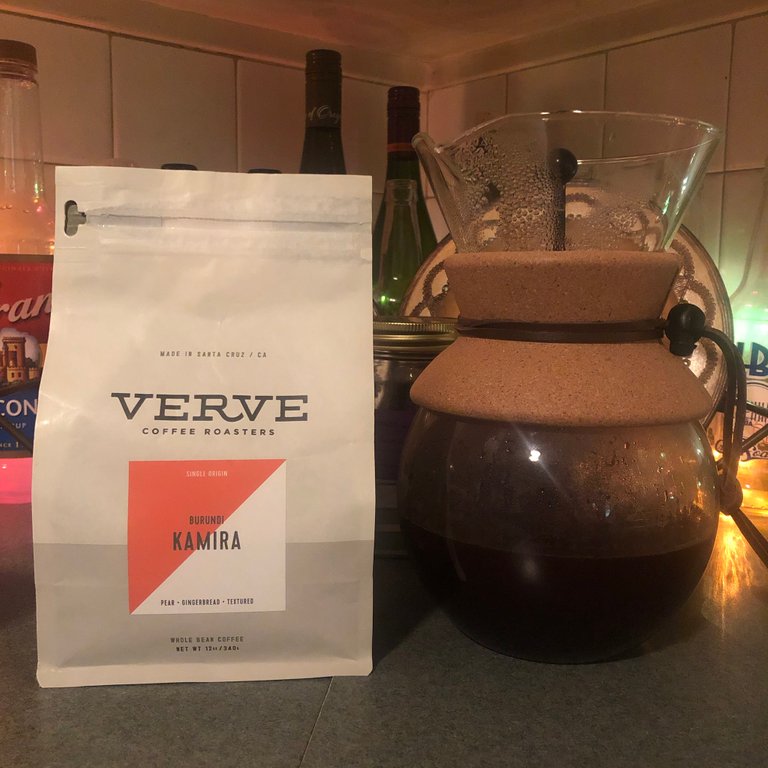
I received an email from Santa Cruz, California’s Verve Coffee Roasters last week about their new offering from Burundi, and I was really stoked to give it a go. Thankfully, I can do double-duty and pick up some of this coffee locally, as there’s a great newish coffee shop here in Springfield, Missouri—Architect Coffee Company—that exclusively brews and sells retail bags of Verve coffee.
I like supporting local when I can, and while Springfield has some good local roasters, I also like being able to get some nationally-noted coffee while supporting local business where I live. Especially lately, as this time is really putting the hurt on small, local businesses. Architect has been great—offering call-in curbside service, in addition to having their lobby open for quick pick-up.
The African coffees offered by Verve are just so good, and I think they might be my favorite roaster of African coffee. Their Kenya Gakuyuini scored a 90 overall in my tasting journal when I experienced it in-house at Architect, artfully brewed with a Hario V60 pour over a few weeks before we were all sheltering in place with this virus situation.
These coffees selected and roasted by Verve are truly elite. What I find to be one of my favorite things about coffees from this roaster are that they pretty much always ring totally true to their bag notes. As I mentioned in my last post, I do not like it when a coffee has to be painstakingly dialed in. Especially when I’m paying anywhere between $15-$25/12oz bag. It starts to feel like a waste—given the time, attention, effort, and resources that go into producing coffee—I HATE wasting it.
Granted, I enjoy the process of dialing in a coffee, but I always want to reach the intended end. I don’t want to feel like I’ve wasted half the bag of coffee trying to dial it in, without ever really reaching the intended tasting notes.
In general, I really like a 1:17 ratio for my pour-overs. Some people like them stronger than that—and that’s totally awesome. But for me, if a coffee is a light roast, single-origin coffee—I want to taste the light and bright notes that are within the cup, and so the 1:17 works well for me.
Worth noting: In my second-wave barista training of the early 2000s, I think a lot of people were under the impression that darker cup of coffee meant a more caffeinated cup of coffee, but this just isn’t true. A coffee doesn’t have to be French-roasted nor does it have to be brewed like syrup to get the desired caffeination out of the cup.
For this Burundi Kamira, I went with a classic pour over method. 30 grams of medium-fine grind beans to 510 grams of water. Initial pour of 60g water with a 45 second bloom, then a pour of 225g at 1:45, and the final pour of 225g at 2:30, with the brew finalized by 3:35. It’s not super often that a brew feels totally dialed in on my first attempt, but with this one—it was just perfect.

Coffees from Burundi are characterized by their approximation to the taste of Kenyan coffees, without as much Kenyan distinction in their flavor and taste. They also are known of having elements of ginger and winter spice. They are gaining popularity by Third-Wave roasters in the United States, and this is the first time I’ve ever tried a single-origin from Burundi. It definitely won’t be my last.
This coffee, based on everything I’ve read about coffees from this country, epitomizes Burundi coffee. It has the Kenyan-esque acidity with notes of pear in both the aroma and taste. It also has a beautiful ginger flavor, amped up with a sweetness of full-on gingerbread.
The aroma is really pleasant and balanced with earthy notes, spice, and pear skin. Flavor notes are sweet, and continue to sweeten as the cup cools. The aftertaste also brings back the pear skin into the profile, along with the earthy notes of the aroma. It is a velvety, yet astringent, full-bodied cup of coffee. The acidity is both tart and sweet, and has a textured, whole-milk body. Super good. A truly balanced cup, that scored an 87/100 in my notes, making it the third-highest ranked coffee in my journal since I started this project.
I am excited to try this coffee in other methods. Next on my list is to brew it with my favorite Aeropress method, and then I might even traditionally cup it to see what other notes come through in those methods. Knowing it shines so brightly with my traditional Chemex-style pour over, makes me excited to see what else I can pull out of it through these other methods.
Also on my list is to try the Chemex method again, only using a paper filter instead of the wire mesh I used on this one. The wire mesh filter allows a lot of the sediment to flow into the cup, especially with a medium-fine grind, and it’s a personal preference for me. I like the sediment. It adds a richness to the cup. However, I’d like to see how bright this coffee truly can be when filtered through paper.
Like I said, I enjoy the process of exploring and dialing in a coffee, but only when I know I can get it to taste the way it’s supposed to. The other methods are just fun to explore. Typically, in my own experience, if it’s good out-the-gate with this 1:17 Chemex recipe, it’s going to be interesting and good in the other methods—my guess is that some will pull out the sweetness moreso (cupping), and others will emphasize the gingerbread and earthy spice notes (Aeropress).
I have been trying to keep up with my coffee journal during the quarantine period, as it provides some fun and some lighter entertainment for me as I’m spending a lot of time studying and playing music—tasting coffee gives my brain a nice break, while also keeping me intellectually engaged.
Thanks for checking out this review and analysis of Verve Coffee Roasters’ Burundi Kamira, and I hope everyone is hanging in there during this trying time. Talk to you soon. Cheers. <3

